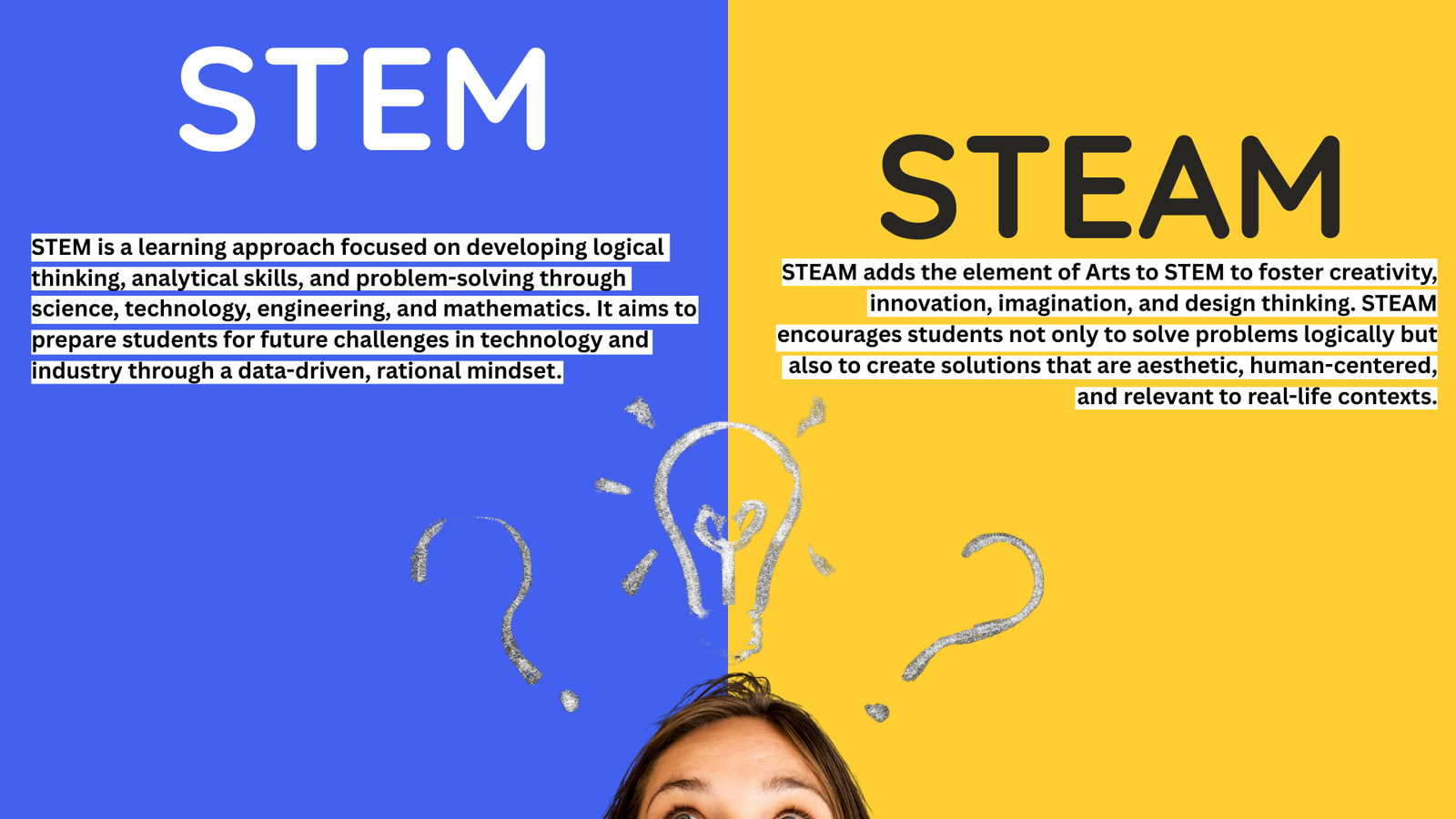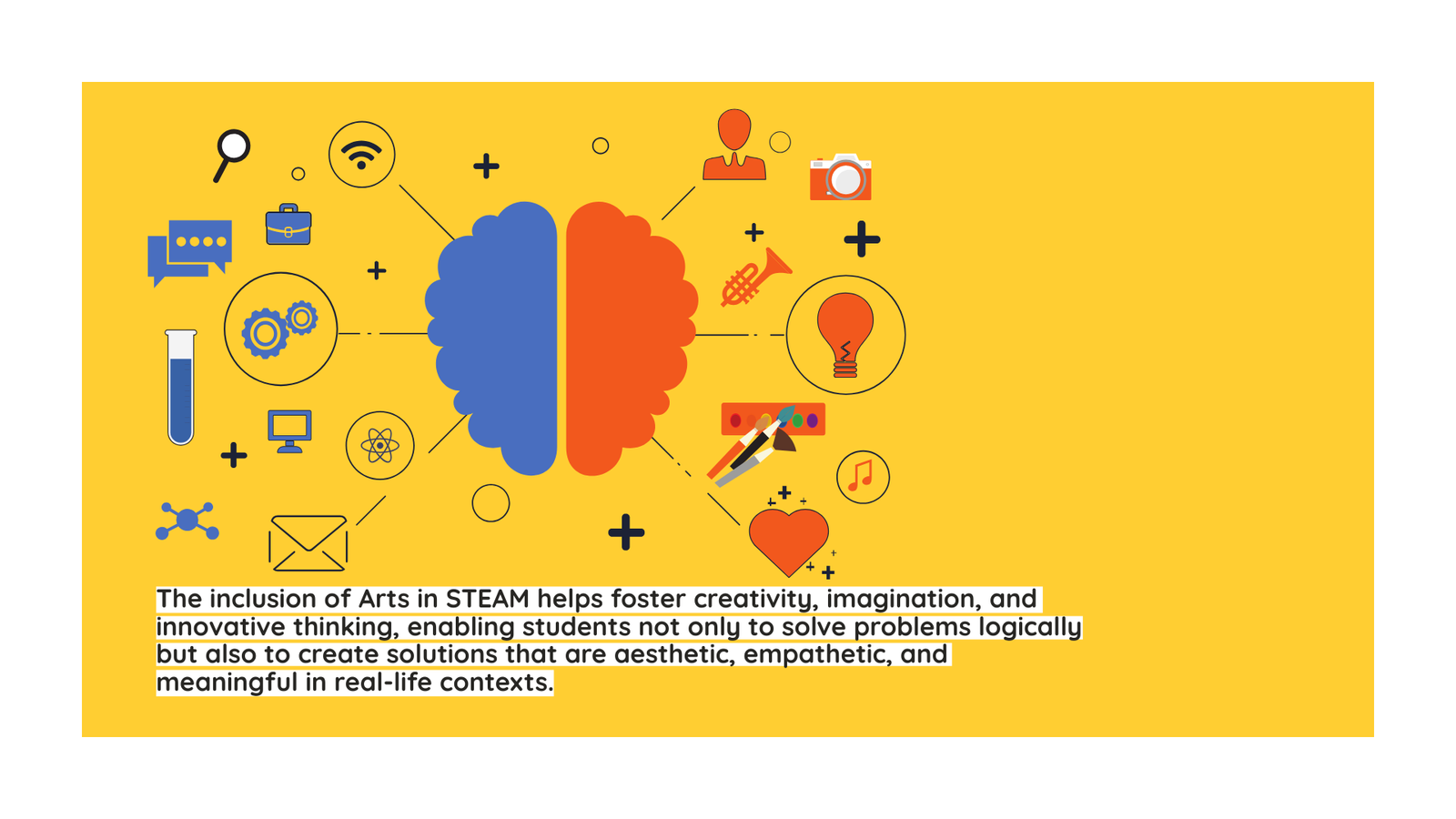Lesson 1.2: Differences Between STEM and STEAM
Comparing STEM and STEAM

The STEM approach (Science, Technology, Engineering, Mathematics) emphasizes the integration of science, technology, engineering, and mathematics disciplines to develop students’ analytical and technical abilities in solving real-world problems systematically (Permatasari et al., 2024). The STEM curriculum is designed to strengthen conceptual knowledge while deepening critical thinking skills and data-driven problem-solving. As explained by Liu, Lou, and Shih (2014), project-based learning in STEM enhances students’ self-efficacy and professional commitment (Liu et al., 2014).
Meanwhile, STEAM adds the ‘A’ from Arts into STEM, integrating creativity and the arts including visual arts, music, and design into the scientific process. This encourages students not only to solve technical problems but also to express aesthetics and produce more imaginative innovations (Sánchez Milara & Cortés Orduña, 2024). According to systematic reviews, the STEAM methodology blends multidisciplinary project-based learning, enhancing student engagement, creativity, and critical thinking simultaneously (Conradty et al., 2020; Aróhunmolase, 2025).
The key difference between STEM and STEAM lies in the focus on engineering versus creativity:
- STEM emphasizes analytical strength and technical precision.
- STEAM introduces a creative perspective that enriches the learning process (Sánchez Milara & Cortés Orduña, 2024).
However, meta-analyses reveal that there is not always statistically significant evidence that STEAM consistently outperforms STEM in improving academic creativity—the outcomes often depend on the design of the intervention, teacher training, and the implementation context (Aróhunmolase, 2025).
Although STEAM can enhance student engagement and learning motivation, its implementation faces major challenges, such as the lack of cross-disciplinary teacher readiness and the persistent siloed structure of schools (Sánchez Milara & Cortés Orduña, 2024). Therefore, reforms in teacher training and curriculum design are necessary to ensure that this disciplinary integration can be effective and sustainable (Sánchez Milara & Cortés Orduña, 2024).
In conclusion, both STEM and STEAM share the same 21st-century educational goals: to produce individuals who are technically competent and critical thinkers. However, STEAM adds an extra dimension of creativity through the arts. The choice between the two approaches should align with the learning objectives:
- STEM is ideal for deepening technical skills,
- STEAM is more suitable when fostering creativity and student motivation is the priority.
If implemented synergistically for example, starting a module with STEAM to spark creativity and then focusing on the technical aspects of STEM learning outcomes can become more optimal and holistic.
The Benefits of Integrating Arts into STEM Education
The integration of the arts into STEM, forming the STEAM approach, has been proven to significantly enhance students’ creativity and divergent thinking abilities. Arts-based activities encourage students to generate multiple, non-linear alternative solutions when facing STEM challenges, a cognitive skill known as divergent thinking, which is essential for scientific and technological innovation (Root-Bernstein et al., 2024). Through the arts, students are invited to imagine and experiment, making the learning process more flexible and deep.
Beyond creativity, this integration also strengthens critical thinking and collaboration skills. Students engaged in STEAM projects learn to communicate ideas visually, share interdisciplinary tasks, and provide constructive feedback all of which are crucial skills for scientific and technical teamwork (Geek Mode, 2024). This method guides them to approach complex problems from multiple perspectives, resulting in more holistic solutions.

Cognitively, the arts also enhance visuo-spatial abilities a key target in understanding mathematical and scientific concepts such as geometry or molecular structures. Meta-analyses have shown that visual training (e.g., drawing, sculpting) significantly improves STEM test scores, particularly for groups traditionally underrepresented in STEM, such as girls and minorities (Uttal & Cohen, 2012). This suggests that integrating arts not only enriches learning but also reduces educational access gaps in STEM.
From a pedagogical perspective, project-based learning (PBL) and problem-based learning emerge as effective strategies for combining the arts with STEM. Designing prototypes that integrate aesthetic principles and scientific techniques trains students to think across disciplines and produce creative products (such as visual art projects), while PBL allows room for exploration and self-reflection (Springer Link, 2024).
For bilingual students or those with language barriers, the integration of arts opens non-verbal pathways—such as imagery, movement, or musicality—to explore scientific concepts. This embodied cognition model reduces anxiety and increases engagement with science content (Wong et al., 2022). The arts offer alternative channels of communication that are more inclusive and promote equitable understanding.
Research also shows that STEAM positively influences intrinsic motivation and student retention. Adolescents, particularly girls from minority groups, demonstrate increased scientific identity and tangible engagement after participating in arts-based programs such as Rising Stargirls in astronomy (Silverman et al., 2025). This provides evidence that the arts are not merely an accessory but a core component in building resilience and a sense of belonging in science.
Overall, the integration of arts into STEM education brings dual benefits: enhancing creativity, critical thinking, communication skills, and inclusivity. Through methods like project-based learning, students not only master STEM content but also develop their artistic expression, thereby expanding the scope of learning to be more meaningful and comprehensive.
Implementation Example: Case Study of STEM vs STEAM Learning
STEM learning (Science, Technology, Engineering, Mathematics) aims to equip students with integrated knowledge and skills across science and technology disciplines without focusing exclusively on a single field. This definition emphasizes the integration of science, technology, engineering, and mathematics in real-world contexts, rather than presenting them separately. A study by Zhan & Niu (2023) indicates that while STEM education initially developed in higher education institutions, it is now increasingly applied at the K-12 level to emphasize its social relevance and connection with the humanities, proving STEM’s potential for interdisciplinary growth.
In contrast, STEAM adds the element of arts and creativity into STEM. This includes music, design, visual arts, and creative thinking, providing students with opportunities to express their aesthetic potential within the context of science and technology learning. Aguilera & Ortiz-Revilla (2021), through a systematic review of 14 studies from 2010–2020, found that both STEM and STEAM show considerable variation in definitions and practical implementation.
Both approaches have been shown to positively enhance student creativity. However, STEAM tends to place greater emphasis on the creative process and contextual learning, while STEM is often more focused on final outcomes or learning products. Nonetheless, there is insufficient evidence to conclude that STEAM is consistently more effective than STEM in fostering creativity, as findings from hybrid studies remain mixed and sometimes contradictory.
Several scientific studies affirm that implementing STEAM yields broader benefits, including improvements in academic achievement, learning motivation, affective skills such as self-confidence and student engagement, as well as the development of critical and creative thinking. Amanova et al. (2025), in a review of 15 articles since 2019, found that STEAM implementation in schools enhanced learning achievement, affective factors, and skills development. The teaching approaches varied, including Project-Based Learning, flipped classrooms, simulation/VR-based learning, with collaborative learning being the most frequently applied strategy.
Additionally, the sequence of material presentation has proven important: one study indicated that initiating lessons with a STEAM approach (arts-first, followed by STEM) led to greater gains in science learning outcomes, particularly for English Learners (ELs) or students with special language needs, compared to the STEM-first method. This suggests that STEAM also holds the potential to improve equity in science education access.
However, there are significant challenges in implementing STEAM, such as the need for teacher training to enable effective interdisciplinary integration, curriculum readiness, and adequate resource management. A study by Boice et al. (2024) concluded that ongoing professional mentoring helps teachers develop STEAM integration strategies tailored to the specific contexts of their schools.
In practical terms, the key advantage of STEAM over STEM lies in its ability to foster a balance between analytical rigor and creativity, broaden students’ skillsets, and strengthen engagement through cross-curricular approaches. Nevertheless, both STEM and STEAM require clear conceptual frameworks to ensure that didactic interventions can be designed, implemented, and evaluated consistently.
In conclusion, if the primary goal is to emphasize creativity and holistic engagement, STEAM is the superior choice. However, if the priority is the efficient mastery of STEM concepts in a structured manner, pure STEM remains appropriate. The best practice would be to adopt a synergistic combination of STEM and STEAM, adjusting the sequence and integration of materials based on the learner’s context—for example, starting with STEAM to build engagement and then deepening learning through STEM for conceptual understanding.
Refrences
Aguilera, D., & Ortiz Revilla, J. (2021). STEM vs. STEAM education and student creativity: A systematic literature review. Education Sciences, 11(7), 331.
Amanova, A. K., Butabayeva, L. A., Abayeva, G. A., Umirbekova, A. N., Abildina, S. K., & Makhmetova, A. A. (2025). A systematic review of the implementation of STEAM education in schools. Eurasia Journal of Mathematics, Science and Technology Education, 21(1), em2568.
Aróhunmolase, A. O. (2025). Integrating Creativity and Rigor: A Comparative Analysis of STEM and STEAM Education and the Transformative Role of Art and Design. Unpublished manuscript.
Boice, K. L., et al. (2024). Exploring teachers’ understanding and implementation of STEAM. Frontiers in Education.
Conradty, C., Sotiriou, S. A., & Bogner, F. X. (2020). How creativity in STEAM modules intervenes with self-efficacy and motivation. Educational Sciences, 11, 331.
Geek Mode. (2024). Integrating Arts into STEM: Enriching Education for Future Innovators.
Liu, X., Lou, S., & Shih, R. (2014). Comparative analysis between a STEM-based learning process and traditional methods: Impact on self-efficacy. Journal of STEM Education.
Permatasari, A., Cahyani, A. D. R., Syihab, H. T., Rohmawati, L., & Sulistina, O. (2024). STEM approach in developing science literacy skills: Review of literature 2016–2023. UNESA Journal of Chemical Education, 13(3), 258–268.
Root-Bernstein, R., et al. (2024). Creativity in STEM and art integration. Journal of STEAM Education.
Sánchez Milara, I., & Cortés Orduña, M. (2024). Possibilities and challenges of STEAM pedagogies. arXiv preprint.
Silverman, M., Shields, A. L., Howard, J. N., Venkatesan, V., & Whitfield, K. (2025). Rising Stargirls: Benefits of a creative arts-based approach to astronomy education for middle-school girls. arXiv.
Unknown author. (2022). Integrating arts with STEM and leading with STEAM to increase… International Journal of STEM Education.
Unknown author. (2024). The impact of STEAM activities on learning outcomes… NASEN Journals.
Uttal, D. H., & Cohen, C. A. (2012). Spatial thinking and STEM success: Evidence from controlled studies.
Wong, S. L., et al. (2022). Integrating arts with STEM and leading with STEAM to increase science learning with equity for emerging bilingual learners in the United States. International Journal of STEM Education, 9, 45.
Zhan, Z., & Niu, S. (2023). Subject integration and theme evolution of STEM education in K–12 and higher education research. Humanities and Social Sciences Communications, 10, 781.
